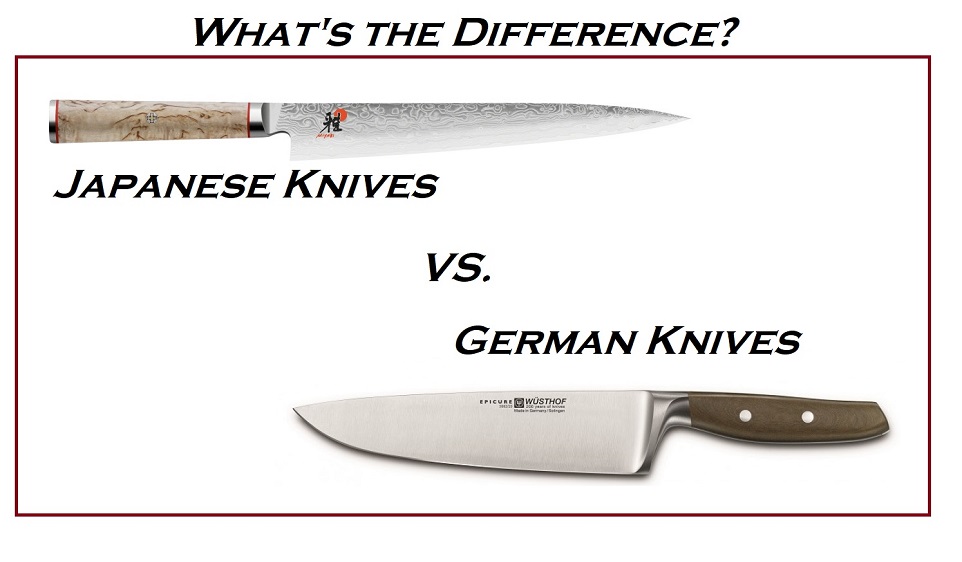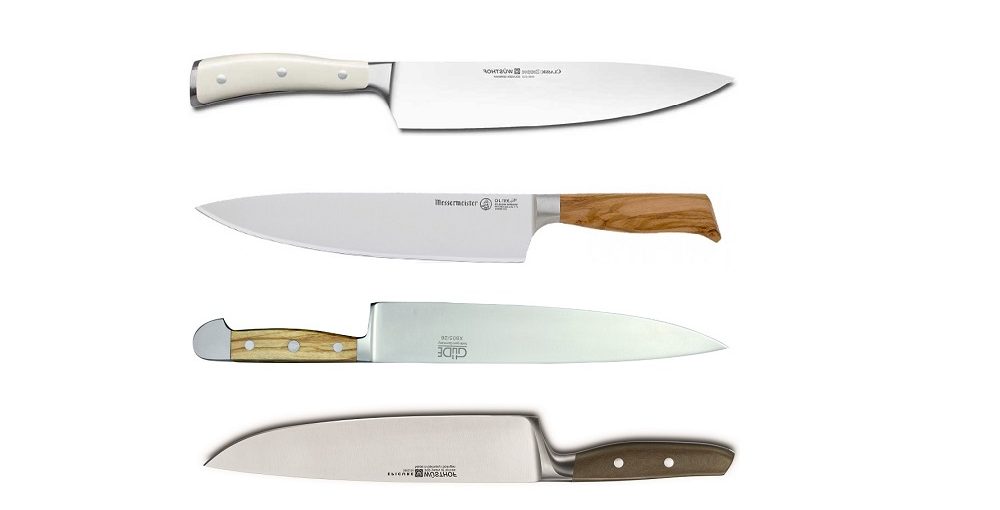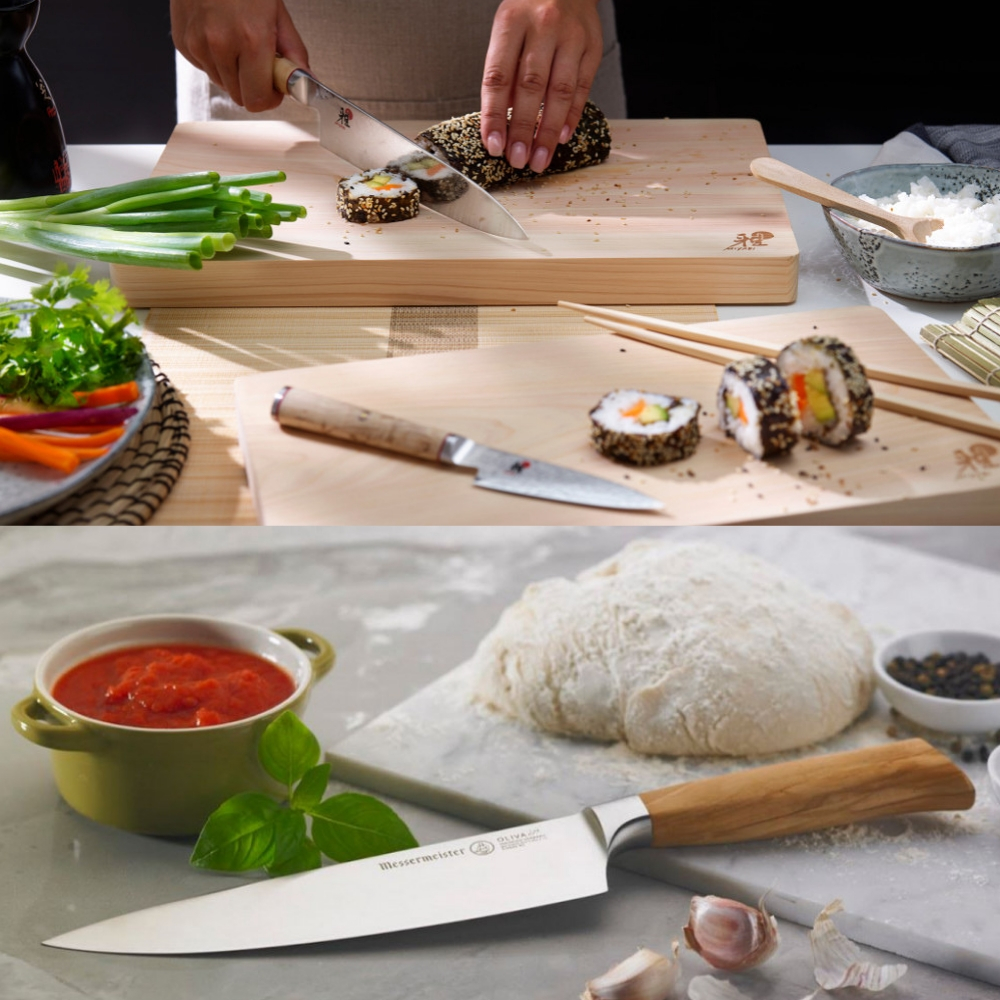 There’s a lot of talk about German knives and Japanese knives. Different types of knives have different uses. It’s also good to always know which knives to use when prepping your food as it does make a substantial difference.
There’s a lot of talk about German knives and Japanese knives. Different types of knives have different uses. It’s also good to always know which knives to use when prepping your food as it does make a substantial difference.
Ultimately, there are a few prevalent features in differentiating its characteristics and it comes down to four things: angle, design, thickness, and material of the blade and handle.
Let’s break down the uses of German and Japanese knives so that you have a clearer and better picture of the two:

German knives are the hard-wearing type of knives. Germans favour durability and versatility when performing in the kitchen.
- Angle/Bevel: The blade angle of German knives are usually 20 degrees; with each bevel (aka angle of the knife) being sharpened to about 10 degrees making the knives less sharp in comparison to Japanese knives. However, its wide feature compensates its sharpness for being better weighted, versatile and durable to cut through tough food.
- Design/Construction: Traditionally, most German knives are constructed to have a full-tang (blade runs from the tip of the knife to the handle) and a bolster (joint part of the steel before the handle). The bolster’s main purpose helps in improving the knives stability and sturdiness making it less flimsy when cutting hard vegetables and tough meat. As most blades are designed to have flat faces, those with ridges for brands like Wusthof and Messermeister (inspired by Japanese santoku design) are made to prevent your food from sticking to the knife while chopping. German knives are also symmetrically designed suitable for both right- or left-handed users.
- Thickness: Generally, German knives are heavier and rougher, they do the heavier work meaning you can easily chop through chicken bones or cut open hard fruits and vegetables. The knives may not have the upper hand in its sharpness but, make up for its hard-wearing versatility.
- Material: Both German and Japanese knives are made of steel but vary in its texture. The Rockwell score is used to determine the hardness of a knife; the greater the number, the harder the steel. The German-made blades are relatively softer (56 to 58 on the Rockwell scale) and don’t need to be sharpened as often. The softer German knives are more durable but, have a reputation of not keeping the edge sharp for long.
Japanese knives take pride in the more delicate works of slicing. Precision is key to the Japanese and their knives clearly show it. The Japanese honed their knives to have a more personal and fine cutting when dealing with fish and poultry.
- Angle/Bevel: Japanese knives tend to have single bevels or in different bevel sizes. Traditionally, the blade angle is relatively smaller, resulting in the blade being much sharper than German knives. The blade angle is usually sharpened to 8 to 15 degrees ideal when making sashimi (like the Miyabi Birchwood sujihiki knife) ensuing in the least damage you’ll do to the food. Some knives are milled edge (like Global knives) for sharper and easier maintenance for a longer time.
- Design/Construction: Famed for its unparallel sharpness, the Japanese knives are often without a bolster – consisting of multiple tangs making it increasingly lighter, harder, sharper and more controlled movements when slicing. The shape of the blade is thinner and straighter edge allowing for cooks to effortlessly glide the blade through without putting much pressure or force into it. Japanese knives are usually not symmetrical as most knives are angled for right-handers. Lefties may not properly use the knives hence, would need to buy a specific left handed knife.
- Thickness: The blade of a Japanese knife is relatively thinner, and light weighted for slicing raw fish and meat into clean slices with ease and the least strength possible.
- Material: Due to a variance in counterfeiting methods, Japanese knives are made from higher carbon steel content making it harder than German knives (60 to 63 on the Rockwell scale). The harder the steel, the sharper the edge – resulting in less sharpening. Japanese knives hold a sharper edge, but because of its great hardness, the blade tends to be more brittle, more likely to rust and chip easily.

So, which type of knife is right for me?
Finding the right type of knife is situational; it all depends on what you’re preparing in the kitchen. If you’re looking for a more durable and general use for cutting meat, vegetables and fruits, opt for the German knives as they are more durable and is more multi-purpose. Brands such as Wusthof, Messermeister, and Gude Die Messer. Wusthof knives are classy, durable and guaranteed strong whereas the Gude Die Messer's fine assortment of knives garners a unique style that always guarantees the right grip and comfort. Renowned for its sturdy and stunning wooden handles, the knives handcrafted by Messermeister, promises a range of quality knives with hand polished edges and great balance.
If you’re seeking for a more specific use to perform clean cuts, delicate and precise slicing of meat and fish, we recommend some of our top selling brands such as Shun, Kasumi, Global, Mac and Miyabi. Famed for its high quality and precision, we recommend our bestselling brands like Shun and Global. Kasumi, Mac and Miyabi each have its personal uniqueness and fine touch to each type of knife.
Be it choosing the German knife or Japanese knife, you’ll be assured that your knife is finely balanced and a pleasure to use.
Like It? Pin It!


